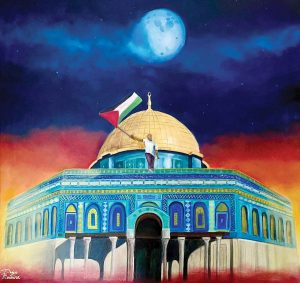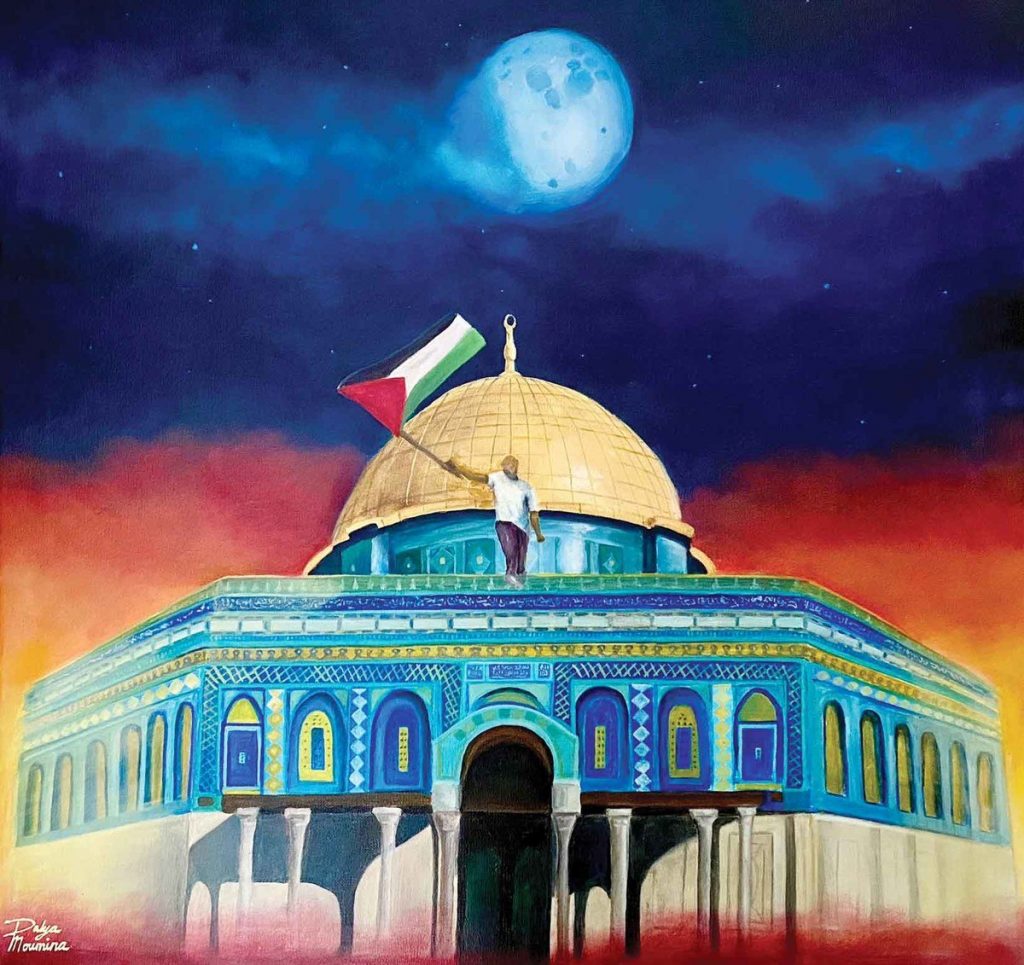Ruba Obaid
JEDDAH: People around the world are using art to talk about the latest events in East Jerusalem and Gaza, with artists using their creativity to express solidarity with the oppressed and stand against injustice.
These conversations are taking place across borders, language and cultures, and artists are launching individual or collective initiatives to keep this dialogue going.
Madinah-based Lujain Ibrahim (@llujaiin) is an up-and-coming artist who is experimenting with embroidery, stitching together vivid scenes from the past few weeks.
One of her pieces depicts Nabil al-Kurd, a 70-year-old Jerusalem resident. He is standing by graffiti on the wall of his home that reads “We will not leave” in Arabic, a statement of his refusal to vacate his home in the city’s Sheikh Jarrah district.

“I’d rather feel an emotion than speak about something as difficult as what’s happening today,” Ibrahim told Arab News. “In my opinion, this has a longer-lasting effect. When I look at my work, I revive a feeling, and it’s a deep one that is felt on a deeper level every time and, once I share that post, I’d like others to look at it in the same light and feel rather than speak.”
This year’s anniversary of the Palestinian Naksa comes as families like Al-Kurd’s live under the threat of imminent eviction by an Israeli court in favor of right-wing settlers.
Israel occupied Palestinian East Jerusalem after its victory in the Six-Day War of June 1967 and formally, though illegally, annexed it in 1980. Since then, subsequent decisions by Israeli courts have paved the way for the army and police to evict Palestinian families from their homes, regardless of international condemnation.
Artist Nasser Almulhim (@nasajm) wrote a love letter for Palestine and its people that features watermelons, which have been a symbol of Palestinian resistance since 1967 when Israel prohibited the display of the Palestinian flag and its colors in the West Bank and Gaza.
I’d rather feel an emotion than speak about something as difficult as what’s happening today.
Lujain Ibrahim
Watermelons, like the Palestinian flag, are red, black, white and green. Although there are different versions of the story behind the watermelon as a symbol, Israeli forces see any manifestation of Palestinian nationalism in occupied territories as a threat. In Sheikh Jarrah, graffiti was erased, balloons pierced, and flags were removed.
While Almulhim did not need to overcome the restrictions imposed by Israeli forces, he still needed to trick the Instagram algorithms that have been criticized for censoring pro-Palestinian content.
With the signing of the Oslo Accords in the 1990s and the Palestine Liberation Organization being recognized as a legitimate representative of the Palestinian people, Palestinian flags showed up again. But the watermelon remains a symbol of resistance and has been revived across social media.

With hundreds of images coming out of Palestine, it is hard to see what is hidden between alleyways and behind closed doors. Children peeking through the laundry hanging from balconies, women cooking in kitchens, and men pushing vegetable carts on the street while navigating their way through the rubble of a bombed building.
Images of violence are splashed across all visual spheres. Still, it is hard to understand and imagine what it is like to live in a land so isolated, so disconnected from the world.
To show such true and on-the-ground images, Saudi photographer Iman Al-Dabbagh (@photosbyiman) took over the @womenphotograph Instagram account.
Jeddah-based Al-Dabbagh curated a virtual exhibition that focused on images from female Palestinian photographers.
Works by Samar Abu Elouf, Fatima Shbair, Rehaf Bataniji, Samar Hazboun, Rula Halawani, Lara Abu Ramadan, Kholood Eid and Eman Mohammed are able to show the true nature of the land as seen from the eye of a Palestinian.
“The Palestinian voice isn’t really heard by the people that should hear it,” Al-Dabbagh told Arab News. “We (in the region) see the matter differently, and I felt the way I could support it is through my community, photographers.”
Al-Dabbagh wanted the audience to sense a human connection and to perhaps change their mind once they realized that Palestinians were ordinary people like them, with normal daily activities, dreams, responsibilities, pains, and laughs.
“Showing images that are different from the typical images that we see from Palestine will get people to want to know who the people of the land are. When you see images of art, music and culture, people from the West identify with it more. I took over this project because I wanted to support the Palestinian women photographers, who are aplenty, show their work to the world and amplify their voice.”
Artist Dalya Moumina (@design.by.dalya) is a granddaughter of a Palestinian refugee. Her grandmother was one of the thousands who were expelled from their home during the 1948 Nakba, and was forced to flee to Jeddah.
I tried to convey my voice as an Arab artist who believes that this is a just cause and is aware of its existence.
Fatimah Al-Nemer
Inspired by her grandmother’s earliest memories of her house in Jerusalem when she was a child, Moumina created a vivid oil painting of the Dome of the Rock within Al-Aqsa Mosque and called it “Rise Again” to depict her grandmother’s childhood view in Palestine.
Moumina has put her painting up for sale in an online auction to raise money for the Palestine Children’s Relief Fund to help families in need. It is also a dedication to her grandmother and her homeland.

Saudi artist, sculptor and photographer Dia Aziz Dia (@diaaziz) shared his work with his fans on Instagram with the caption “Israeli Barbarism,” which he created during different periods of the Palestinian struggle.
His work is meant to be received as powerful and self-explanatory. They express deep pain and grief, but also determination and resilience.
“Once the artist has the skill to express his own imagination, and as long as he is aware of the events that affect his own life and the lives of his local and regional community, then I think that he must share his opinions and views, and express his feelings toward what is happening,” Dia told Arab News. “The artist holds an influential means of expression. It is one of the most powerful means of expression.”

There can be no conversation about Palestine without mention of the late Palestinian poet Mahmoud Darwish.
Saudi artist Taghreed Al-Bagshi (@tagreedbagshi) created a piece of art to express his solidarity and captioned it with lines from Darwish’s poetry: “We have on this earth what makes life worth living, on this earth stands the mistress of the earth, mother of beginnings, mother of endings, known as Palestine, and became Palestine.”
Al-Bagshi said the work was driven by the overwhelming emotions she experienced while watching the news and her heartfelt wishes for peace and love to Palestinian children.
“I am a peace advocate myself,” Al-Bagshi told Arab News. “Seeing children and families living under threat of losing their homes, hope, lives and their moments of peace at any given second gives me great distress. Ordinary children do not understand what sadness as a word means, but Palestinian children have experienced it at a very young age and are growing up with it. I painted life in the mother, peace in the white pigeons, hope in the open sky, and the call for the stolen childhood to be returned back in children’s eyes.”

Darwish also inspired the artwork of Fatimah Al-Nemer (@artistfatimahalnemer). She drew on his poem “Put it on record – I am an Arab” to reflect the resilience and pride of the Arab and the Palestinian living under occupation.
“I tried to convey my voice as an Arab artist who believes that this is a just cause and is aware of its existence,” she told Arab News. “As artists we support Palestinians with our colors and paintings. I believe that an artist without a purpose and a call is not a true artist. Art is an honest practice above all. It has to be honest to speak to the inner hearts of others.”























